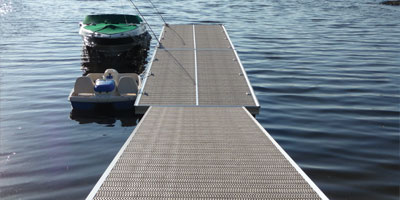A Pipe Dock refers to a dock which is on pipe legs. It is considerably more stable than a floating dock and are more cost effective. They have more flexibility when selecting design layouts and are usually easily expanded/added to. Pipe dock systems are usually light weight and designed to be removed for the winter. There are also tower designs that allow them to be cantilevered up in the winter. Since pipe docks are not submerged under water they have little impact on the environment. DockinaBox® manufactures different series of pipe docks each for specific water conditions and usage.
A pipe dock system is generally used where the water is less than 8 feet deep and the lake bottom is fairly solid. If the bottom is soft and allows you to sink more than 6 inches when walking then a mud pad may be required. If the lake bottom is super soft or the water depth is over 8 feet, then a floating dock would be the best alternative.
Pipe docks are the right choice of dock where the water level variance is about 30 inches or less throughout the boating season.
Here are the most frequently asked questions by cottagers:










